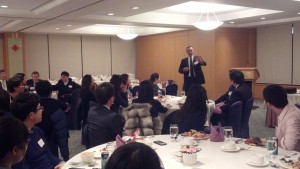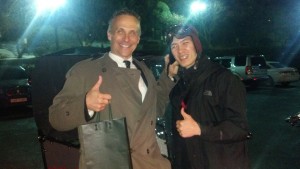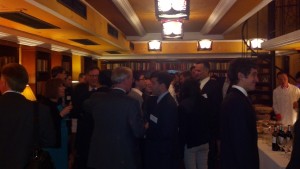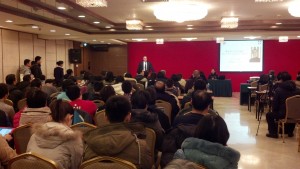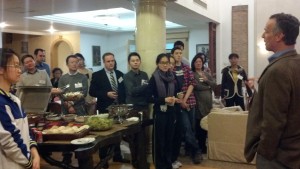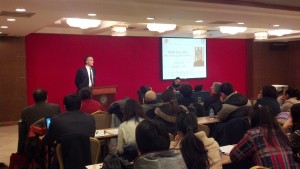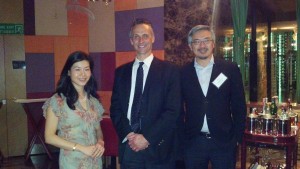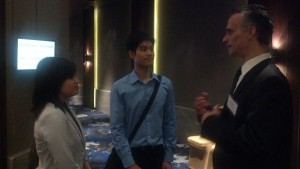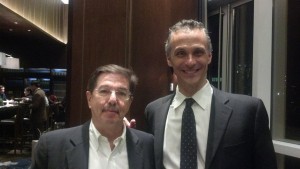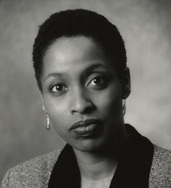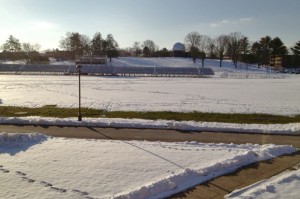From Sunday’s Washington Post:
HALLUCINATIONS By Oliver Sacks. Knopf. 326 pp. $26.95
As a young professor, I traveled to Vienna to visit a friend. Knowing that I’d written my first book on psychoanalysis and history, he sent me off to Freud’s old apartment and office, which had been converted to a museum. One rang a doorbell to be admitted, and I was shocked when the museum attendant greeted me by name. Surely, I thought, my old friend had called ahead to play a little joke on me. Again, the attendant spoke to me by name in German, calling me “Professor Doktor Roth” — or so I thought. My wife was right beside me, and she later told me that nothing of the kind had happened. The museum employee had merely told me the price of admission.
I was befuddled by this, and later as I searched in the museum’s library to see if it had a copy of my book, I realized that what I’d heard so clearly was probably an auditory hallucination. I so very much wanted to be recognized in the house of Freud that I’d perceived something that wasn’t there at all.
Most of the examples of hallucinations in Oliver Sacks’s graceful and informative new book do not have the transparent motivations of my episode in the Freud museum. Indeed, most of his examples don’t seem “motivated” at all; they have causes rather than meanings. That is, most of the occurrences seem to be products of neurological misfirings that can be traced to disease, drugs or various changes in neurochemistry. With some important exceptions, hallucinations don’t seem to reveal desires or intentions — the kinds of things that create meaning; they do reflect workings of the brain that cause us to see or hear things that are not really there. Parkinsonian disorders, epilepsy, Charles Bonnet syndrome, migraines and narcolepsy — drawing upon descriptions of these and other conditions by patients and doctors, Sacks explores the surprising ways in which our brains call up simulated realities that are almost indistinguishable from normal perceptions.
As is usually the case with the good doctor Sacks, we are prescribed no overarching theory or even a central argument to unite his various observations. Instead, we are the beneficiaries of his keen observational sense, deep clinical practice and wide-ranging reading in the history of neurology. This doctor cares deeply about his patients’ experiences — about their lives, not just about their diseases. Through his accounts we can imagine what it is like to find that our perceptions don’t hook on to reality — that our brains are constructing a world that nobody else can see, hear or touch.
Sacks has been fascinated by neurology since his student days (he is now almost 80), and he recounts his personal experiences with neurochemistry. He started experimenting with LSD in the 1950s, and when he was a medical resident living in Southern California’s Topanga Canyon in the 1960s, his drug use combined recreation with investigation. Opiates later upped the ante, and Sacks describes his interest and pleasure in altered states of consciousness. He recalls his hallucinations that drew heavily on Froissart and Shakespeare with neither pride nor shame. His perceptions weren’t based in reality, but could he still learn from them?
Sacks has long been an avid reader of the history of medicine, and he beautifully describes his intense, amphetamine-inflected readings of such 19th-century medical texts as the English physician Edward Liveing’s work on migraines. Drugs made reading seem more powerful, but as he came down from his high, Sacks realized that while under the influence of drugs he would never be able to write with the kind of sustained attention and care evident in the texts he admired. His epiphany was that he should follow his creative muse not through more powerful hallucinations but through the work of medicine and writing. “The joy I got from doing this was real — infinitely more substantial than the vapid mania of amphetamines.”
Over the past decades we have learned much more about how we see and hear with our brains — not just with our eyes and ears. Sacks describes how neurosurgeon Wilder Penfield was able to induce “experiential seizures” by tracking electrodes over the surface of an exposed temporal cortex during surgery. His patients seemed to experience vivid flashbacks, as if the electrical charge had catalyzed a memory into a perception. Vivid though they were, these recollections seemed to lack personal significance. More recent work has explored how the brain creates networks of recollection that allow us to access memories, even as we reshape the past while bringing it into consciousness.
Some hallucinations, Sacks writes, do seem connected to highly significant, emotionally charged memories. When deep in grief, for example, we are more likely to perceive our loved one, even though we know that person has died. Bereavement “causes a sudden hole in one’s life,” and a hallucination evinces a “painful longing for reality to be otherwise.”
At the end of “Hallucinations,” Sacks returns to phantom limbs, a subject he wrote about at length in “A Leg to Stand On.” Amputees report pain in limbs they no longer physically possess, the brain seeming to retain an image of the body that trumps physical reality. Physicians today help patients learn to use their phantom limbs, fitting them into prostheses so that they can use their hallucination of a body part to maneuver what no longer seems like an artificial limb.
Turning a phantom limb from something strange and painful into something one integrates with one’s sense of self is a medical and human triumph. Sacks has turned hallucinations from something bizarre and frightening into something that seems part of what it means to be a person. His book, too, is a medical and human triumph.
From Sunday’s Los Angeles Times
Glittering Images: A Journey Through Art From Egypt to Star Wars. By Camille Paglia. Pantheon: 202 pp., $30
In the 1990s Camille Paglia established herself as a cultural critic to be reckoned with. Her daring “Sexual Personae” enraged feminists, even as it presented a view of culture, sexuality and control that offered little comfort to conservatives hoping to convert even more Americans to the cult of conventionality. Chaos, Paglia emphasized, might be contained for a while, but it would always find its way back into our lives. And that wasn’t something to be lamented.
Paglia was a radical libertarian eager to puncture sanctimony wherever she found it — either in the progressive pieties of political correctness or in the hypocrisy of fundamentalist hucksters hacking away at other people’s pleasures.
She enjoyed a fight, or at least she recognized that fights made good copy and pumped up sales. She liked to throw around the word “Stalinist” and was herself compared to both a Nazi and to Phyllis Schlafly by prominent feminist authors. Paglia particularly enjoyed polemics against pretentious academics, reserving some of her nastiest and most amusing tirades for the followers of highfalutin French theory. This too was a guaranteed audience pleaser.
In the last decade we have seen a kinder and gentler Camille Paglia as she has moved from critical polemic to cultural appreciation. In “Break, Blow, Burn” she turned her attention to what she considered great poetry in English — from Shakespeare to Joni Mitchell. Taking a page (and perhaps a business plan) from her mentor Harold Bloom, Paglia wrote in that book that in “this time of foreboding about the future of Western culture, it is crucial to identify and preserve our finest artifacts.” She collected 43 mostly canonical poems and wrote a little about each in the hope the inspiration she found in them would be contagious.
“Glittering Images” continues this project — this time with brief discussions of 29 works of visual art. Whereas “Break, Blow, Burn” sought to help us hear again the strongest poetic voices, this volume wants to help readers “find focus” amid the “torrential stream of flickering images.”
Paglia’s goal is straightforward: By offering images of great artworks and helping us to give them sustained attention, she hopes that readers will “relearn how to see” with sustained pleasure and insight. Protesting against the intense animosity toward the arts she sees in American popular culture, Paglia wants her readers to recognize the deep feeling, craft and originality that went into the works she has chosen.
The range of art discussed is enormous, though there are few surprises in the Paglia canon. She begins with Nefertari’s tomb and offers a few pages on religion and politics in ancient Egypt and on Egyptology since Napoleon. The anonymous artisans who built the tomb “were faithful messengers of the cultural code,” linking profound cultural truths to elegant visual representation. Paglia’s sympathy for the intersection of religion and art serves her well in the early chapters of the book, as she discusses objects that were venerated for more than their aesthetic power.
Given her penchant for polemic, it was odd to discover that “Glittering Images” has no argument. Her brief discussions of the objects have the flavor of the textbook or Wikipedia, with occasional anachronistic comments linking them to present concerns. It’s probably a good thing that Paglia makes no attempt to sustain a narrative about art over the ages; instead she offers reflections on why she finds, say, Donatello’s Mary Magdalene so powerfully enigmatic, or why Bronzino’s mannerism has “a polished theatricality but an unsettling stasis.”
It would be silly to complain about the particular works that Paglia has chosen. They all repay vision and reflection, and that, after all, is her point. The critic sometimes seems to believe, with George Grosz, that “great art must be discernible to everyone,” and I suppose that’s why she concludes her survey with the limited imagination but visual virtuosity of George Lucas.
In her final chapter she writes as if popularity is a key sign of artistic greatness, though she knows that many of the artists she most admires were not at all part of the popular culture of their times. They often struggled to be seen, but that doesn’t mean that fame was their ultimate artistic goal.
I’m not sure why Paglia worries so that the fine arts today have lost touch with the masses, that they “are shrinking and receding everywhere in the world.” Sure, her favorite AM talk radio shows often make fun of artists. But people have been making fun of artists for a very long time. Meanwhile, contemporary photographers, painters, sculptors and videographers pursue their practice with intensity and patience, with craft and concept.
Toward the end of “Glittering Images,” Paglia writes with appropriate and infectious admiration about Eleanor Antin’s mail art project 100 Boots. Paglia notes that the “boots, like their creator, are outsiders, eternal migrants questing for knowledge and experience.”
Artists, questing outsiders, are still with us, still finding their way, making their way. Perhaps some of them will be inspired by the glittering images Camille Paglia offers here.
